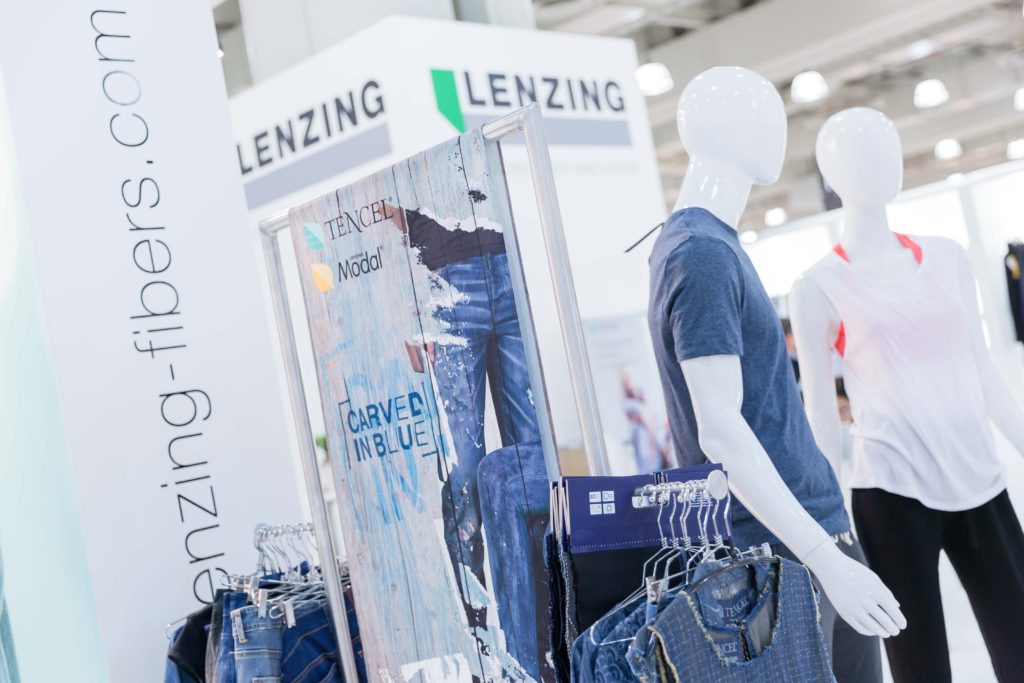
Sustainability Drives Innovation in Fashion
Soft and smooth are two words that immediately jump to mind at the mention of TENCEL®, the branded lyocell fiber from Lenzing. Used in activewear, denim, knits and home since it launched in the early ’90s, it also provides many functional benefits to fabrics.
The third element that completes the jigsaw is the sustainability aspect. While TENCEL® is man-made, it should not be confused with the generic rayon. Though both fibers are made from the natural polymer cellulose, and both are derived from dissolved wood pulp, the “lyocell process” is significantly different to that of the “viscose process”.
An elegantly simple process, the lyocell process uses one solvent and water in a “closed loop” arrangement. That means the solvent is continuously removed from the resultant fiber, filtered and reused. Rayon, by comparison, is produced in a process which is linear and is energy and chemical intensive and potentially polluting if significant measures are not taken.
And yet, while it’s been on the market for more than 20 years (first production was in Mobile, Alabama, in 1992), TENCEL® is still thought of as the new kid on the block, explained Lenzing’s director of business development for denim, Tricia Carey, during day one of the summer edition of Texworld USA in New York.
She was speaking as part of the trade show’s brand-new educational boot camp series, highlighting the perks of using Lenzing Modal® and TENCEL® in apparel and home, alongside Jeff Wilson, director of business strategy and development at Textile Exchange, who addressed organic cotton and recycled polyester.
The reason TENCEL® is still considered “new” amongst consumers, Carey said, is because a lot of them haven’t been asking about sustainable alternatives until now.
“Sustainability is very important to Lenzing. It’s integrated within everything that we do,” Carey continued, pointing out that the company has been fielding more and more questions of late about the origin of its pulp.
“Some of this has been led by outside NGOs making sure that endangered or old forests are not being used,” she added, noting that all Lenzing’s pulp are FSC (Forest Stewardship Council) and PEFC (Programme for the Endorsement of Forest Certification) certified or controlled. “So we’re not sourcing from any controversial sources at all.”
In fact, Lenzing makes about 50 percent of its own pulp, even finding use for its byproducts: bark from the trees is burned for fuel for the plant, or acetic acid is sold to the food industry.
“We’re listening to the market and what’s needed, and really a lot of these concerns with sustainability are just coming together, and this is why we’re working with organizations like Textile Exchange,” Carey said, but quickly noted, “Are brands willing to pay more? Is the consumer willing to pay more? This is something we really struggle with as an industry. We want more out of our products and we say we want performance, we need innovation, we need technology, but that does come at a cost.”
Wilson said there’s no reason why TENCEL® or recycled polyester can’t be economically competitive with conventional fibers if big brands start asking for more. Using LED lighting as an example, he explained that one LED light bulb retailed for about $25 five years ago, compared to roughly $5 today.
“That’s come about because of market demand, driven partially by consumer demand. They’ve reached scale and can produce LED bulbs and make a profit for $5 now,” he said. “Do we have a long way to go? We sure do. But we do need bigger investments from the brands to signal demand, drive volume and lower production costs.”
That being said, consumers are slowly coming around, as they have always done. Just look at the evolution of Lenzing: in response to market shifts, each generation of its fibers has been more environmentally responsible than the last. Issues concerning Lenzing Viscose®, which it’s been producing for 75 years, were solved with Lenzing Modal®, which has been on the market for half a century. And its issues were then solved with TENCEL®, dubbed “the fiber of the future.” Lenzing will continue to drive innovation with new product developments.
In fact, it’s launching a new TENCEL® fiber made from cotton waste fabrics to drive “circular economy” solutions in the textile industry. The new generation of lyocell fibers will be the most ecological wood-based fiber on the planet–combining cotton waste recycling with Lenzing’s pioneering closed-loop TENCEL® production on a commercial scale.
“It’s important that Lenzing is investing in the next generation of technology. And I think a lot of it has to come from market demand. If we can make it and there’s a market for it then it’s all going to happen,” Carey said. “Growing up I never recycled cans and plastics. Now in my kitchen I have my own garbage can just for that because it’s how we are now. Eventually I think we will reach that point with textiles, too.”






